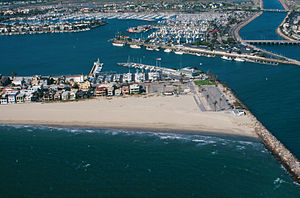
Back حاجز أمواج Arabic Ruempefoles AST Dalğaqıran Azerbaijani Вълнолом Bulgarian Escullera Catalan Vlnolam Czech Mole Danish Wellenbrecher (Wasserbau) German Κυματοθραύστης Greek Rompeolas Spanish



A breakwater is a permanent structure constructed at a coastal area to protect against tides, currents, waves, and storm surges. Breakwaters have been built since antiquity to protect anchorages, helping isolate vessels from marine hazards such as wind-driven waves.[1] A breakwater, also known in some contexts as a jetty or a mole, may be connected to land or freestanding, and may contain a walkway or road for vehicle access.
Part of a coastal management system, breakwaters are installed parallel to the shore to minimize erosion. On beaches where longshore drift threatens the erosion of beach material, smaller structures on the beach may be installed, usually perpendicular to the water's edge. Their action on waves and current is intended to slow the longshore drift and discourage mobilisation of beach material. In this usage they are more usually referred to as groynes.